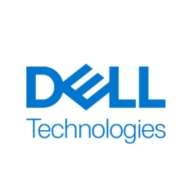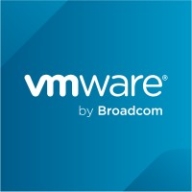

VMware vSAN and Dell PowerFlex are major players in the hyper-converged infrastructure category. VMware vSAN holds an edge due to its seamless integration and cost-effectiveness on commoditized hardware, while Dell PowerFlex commands attention with superior scalability and performance benefits.
Features: VMware vSAN offers excellent integration with existing VMware solutions, flexibility in scaling, and a reputation for simplicity and cost-effectiveness on standard hardware. Dell PowerFlex provides significant scalability with independent compute and storage scaling, low-latency performance, and robust resiliency in diverse deployment architectures.
Room for Improvement: VMware vSAN could benefit from better deduplication, hardware compatibility, and enhanced protocol integration. Additionally, improvements in customization and warranty support are necessary. Dell PowerFlex needs enhancements in automation, pricing competitiveness, as well as AI integration and a focus on scaling flexibility for smaller businesses.
Ease of Deployment and Customer Service: VMware vSAN is known for its straightforward setup and a user-friendly management interface, though support response times can vary. Dell PowerFlex also offers a simple deployment process but emphasizes self-reliance to cut down on its generally expensive support services.
Pricing and ROI: VMware vSAN is priced per CPU and provides cost benefits through integration and simplicity, although initial costs may be high. Dell PowerFlex is perceived as more costly but offers scalability and performance advantages that validate its premium pricing. Both solutions contribute to lowering infrastructure costs, with VMware vSAN being noted for significantly reducing server and storage expenses.
Starting with a smaller infrastructure and scaling as required allows us to save costs initially.
I have seen a return on investment; it's satisfactory in the long run.
The level of support needs improvement as the front-line support staff lack knowledge when we raise cases.
We do not have local Dell technical support.
I would rate their support nine points.
I am not satisfied with VMware support, particularly with the reaction times, SLAs, and those kinds of issues.
Sometimes the issue is that you don't get the best experience, whether it's the response time or first-level support quality.
The scalability is very good and is one of the key features of Dell PowerFlex.
It supports up to 64 nodes in a cluster, allowing us to add nodes and expand the cluster as needed.
In terms of stability, I give VMware vSAN nine points.
They could have more AI functionality in the future.
The level of support needs improvement as the front-line support staff lack knowledge when we raise cases.
As more customers start deployment, I believe use cases will develop, leading companies to consider that.
A proper monitoring tool that encompasses both applications and infrastructure would help in quickly resolving issues.
Maybe incorporation of automation to build clusters in a more automated way would be beneficial.
This has resulted in a slight cost increase.
Dell PowerFlex includes PowerFlex Manager, which integrates with this solution to provide complete orchestration; you can manage your entire hardware as well as software segment and application segment through a single pane of glass, making it very easy to use and manage.
The scalability is very good and is one of the key features of Dell PowerFlex.
Hot add features are available by default in vSphere, allowing us to immediately increase memory, CPU, and hard drive without any downtime.
The VMware vSAN feature that has had the greatest impact on operational efficiency is the basic software-defined storage functionality.
A one-stack solution from one vendor is the main benefit here.
| Product | Market Share (%) |
|---|---|
| VMware vSAN | 13.0% |
| Dell PowerFlex | 8.8% |
| Other | 78.2% |


| Company Size | Count |
|---|---|
| Small Business | 8 |
| Midsize Enterprise | 8 |
| Large Enterprise | 15 |
| Company Size | Count |
|---|---|
| Small Business | 98 |
| Midsize Enterprise | 58 |
| Large Enterprise | 128 |
Dell PowerFlex is a software-defined storage infrastructure delivering modern architecture and versatile deployment for on-premises or cloud. It achieves high performance, scalable storage, and workload consolidation through advanced automation.
PowerFlex's VMware compatibility ensures seamless integration, offering flexibility in compute and storage scaling. With its hyper-converged infrastructure, it caters to AI, cloud, and database environments, providing robust automation, resilience, and security. Flexible deployment options are complemented by a single-window management system, prioritizing cost optimization. However, enhancements are needed in monitoring tools, user interface, and AI functionality. Migration from Hyper-V and licensing flexibility also require attention, while improved documentation could simplify usage. Integration with services and streamlined upgrade processes are essential.
What are the key features of Dell PowerFlex?PowerFlex is essential in industries requiring support for mission-critical workloads and large-scale applications. It is instrumental for deploying storage, compute nodes, hyper-converged infrastructure, and private clouds. The platform integrates compute, storage, and networking, optimizing performance for modern applications like AI video analytics and disaster recovery.
VMware vSAN is a software-defined storage product that is used in collaboration with VMware ESXi hypervisor and that provisions and manages storage based on policies, regardless of the underlying hardware. The solution enables you to prime your business for growth through its seamless evolution (it is integrated with vSphere and requires no new tools), its flexibility, and its multi-cloud capabilities. As an industry-leading software, VMware vSAN provides high levels of performance with minimal impact on CPU and memory.
VMware vSAN Features
VMware vSAN has many valuable key features. Some of the most useful ones include:
VMware vSAN Benefits
There are many benefits to implementing VMware vSAN. Some of the biggest advantages the solution offers include:
Reviews from Real Users
Below are some reviews and helpful feedback written by PeerSpot users currently using the VMware vSAN solution.
PeerSpot user Yves S., CEO, Cloud Evangelist at Comdivision Consulting GmbH, says, “vSAN gives us a lot of advantages when we need to expand resources. We have an overall larger host infrastructure, and we split that up for specific customer test and use cases. In that specific scenario, we can easily add more hosts or reduce the number of hosts in the environment.”
A reviewer who works in Infrastructure Security explains, “The ease of use is great. The initial setup and upgrade process was pretty straightforward. And, technical support is great.”
Laurent N., Director at Softlogic, comments, "The feature that I have found most valuable is that it is easy to deploy. It is easy to create and delete virtual servers. It is easy to create the load balancing and the clustering."
We monitor all HCI reviews to prevent fraudulent reviews and keep review quality high. We do not post reviews by company employees or direct competitors. We validate each review for authenticity via cross-reference with LinkedIn, and personal follow-up with the reviewer when necessary.